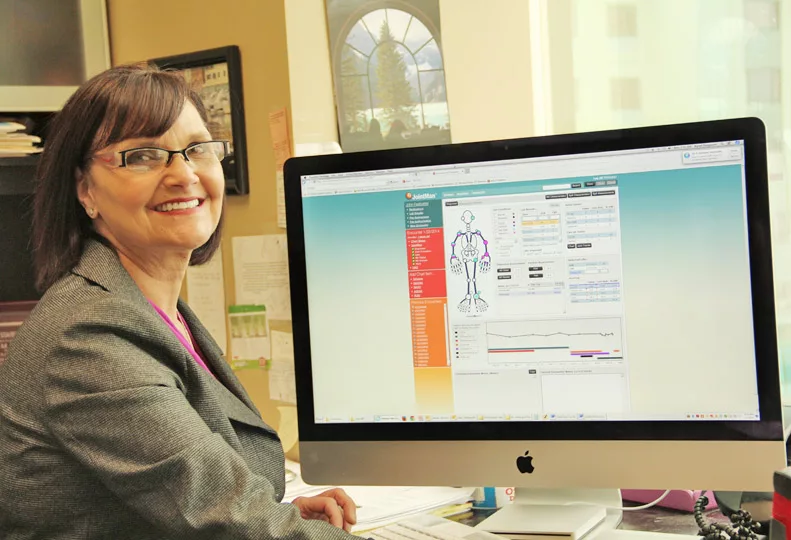Using software to treat rheumatoid arthritis
Company, practice here join to invent, market app

Discus Analytics LLC, which launched in Spokane in May 2011, has collaborated with doctors here to invent and begin marketing a software application designed to help better treat rheumatoid arthritis and its progression.
The company worked with physicians from the Spokane-based Arthritis Northwest practice to create the software product suite, named JointMan, says Karen Ferguson, the company’s CEO and Arthritis Northwest’s practice administrator.
Discus Analytics received a patent for JointMan in June 2013, and since then has been marketing the product to providers of electronic health care systems that are used in hospitals and private practices, Ferguson says. The JointMan software is made specifically to integrate with whatever electronic health record system a hospital or practice has in place, Ferguson says, such as the Epic and NextGen systems.
“This becomes a tool that plugs right into the system,” she says.
Looking to the future, Ferguson says that JointMan could have many applications for other diseases and conditions. She says that Discus Analytics already is looking at creating more uses for the program and broadening it into other areas.
“It could be HeartMan,” she says. “The platform is set for it to go into other specialties.”
Discus Analytics, which has 10 employees, and Arthritis Northwest, which has about 50 employees, both operate out of the Sacred Heart Doctors Building, at 105 W. Fifth. However, Ferguson says, Discus Analytics is currently looking for its own space in Spokane to expand the company to its goal operational status within this year. She says the company also is planning to add more employees in the near future.
The JointMan program enables doctors to track data related to rheumatoid arthritis patients in real time, says Ferguson.
“The program is a tool used in real time to track the patient outcomes and the efficacy of their treatment plan,” Ferguson says.
When a patient comes in for an appointment, he or she first uses a computer to fill out a health questionnaire that asks questions about overall feeling of health, function levels, and severity of pain. It also asks general questions about sleep and anxiety.
The health questionnaire responses are entered into the patient’s JointMan electronic record. When the doctor examines the patient, the results of the health questionnaire are shown in the patient’s profile. The doctor then inputs information from the examination, including a “joint count,” noting how many of the patient’s joints are swollen and painful.
During a joint count, a doctor feels the patient’s joints to check for inflammation and pain. If pain or swelling are present, or if a joint is normal or has been replaced, the doctor can click on a corresponding color in the JointMan program, and that joint will show that color on the JointMan homunculus, or an anatomical diagram with circles at all the body’s joints.
The program tracks changes in responses to the health questionnaire and examination questions, as well as joint counts over time, and creates a graph that shows the results against the medications and treatments the patient is using or receiving. If the graph shows that the patient has had an increase in pain or a decrease in function, for example, the doctor can change the medication, Ferguson says.
After all the data for a particular appointment has been entered, the program makes a chart note for the doctor, which is a synopsis of all the data collected from that visit and previous visits. The chart note remains attached to the patient’s electronic record.
The program also shows data for all of the patients within a practice, Ferguson says, so the doctors can see which patients have more disease activity and less control over their disease, and might need more care assistance than others.
One of the advantages of JointMan is that it incorporates data from previous visits into the metrics to show overall patient trends, Ferguson says.
“This shows in metric form and structured data what’s going on,” she says.
Dr. Sergio Schwartzman, chief medical research officer and board member for Discus Analytics, says that JointMan gives doctors an objective data source for analyzing treatment options.
“Doctors make a lot of decisions based on that first question, ‘How are you doing?’” he says. “Now instead of being subjective, we have a tool that is objective.”
Arthritis Northwest opened in 1992 with Drs. Howard Kenney and Jon Stevenson, who has since retired. The practice offers comprehensive diagnoses and treatments for arthritis, rheumatoid arthritis, osteoarthritis, scleroderma, lupus, and metabolic diseases such as osteoporosis.
The idea for the JointMan program dates back to 2009, Ferguson says, when she and others from Arthritis Northwest attended a medical conference and heard a speaker on the Affordable Care Act. One of the topics involved was “quality metrics”, which refers to measuring analytically a person’s health status and detailing specific changes in that status over time in response to treatments and medications.
After the conference, the team began to think about quality metrics in rheumatology. One concern, Ferguson says, is that many drugs used to treat rheumatoid arthritis are expensive.
“In tomorrow’s landscape, we need to be able to show the efficacy of those drugs,” she says.
Schwartzman also says that metrics aren’t as widely used in the U.S. as they are in other parts of the world.
“Doctors in the U.S. haven’t been as aggressive in using metrics as doctors in Europe,” he says. “Much of it is coming from outside insurance; outcome measurements are being demanded.”
Another upcoming change to the landscape of health care, Ferguson says, is the shift towards more accountability for doctors. A report published in March of 2013 by the National Commission on Physician Payment Reform asserted that in order to curb health care spending, the way in which doctors are paid needs to change.
“Physicians will soon be legislatively required to show standard of care,” Ferguson says. “The biggest legislative movement is going from fee-for-service to paying for value.”
Soon, she says, doctors won’t be paid for the treatments they order for patients, but rather for what they don’t order. This is part of the pay-for-performance movement, which aims to have doctors be paid not merely for reporting conditions and treatments, but for actually improving patient outcomes.
Ferguson also says more health centers will be working toward what’s known as the triple aim. First put forth by the Institute for Healthcare Improvement, the three aims are meant to optimize health care by improving patient care and experience, improving overall health of populations, and reducing the per-capita cost of health care.
“This program helps doctors be accountable for their quality of care, working in alignment with hospitals and electronic health record models,” Ferguson says.
Related Articles
Related Products

_c.webp?t=1763626051)
_web.webp?t=1764835652)

